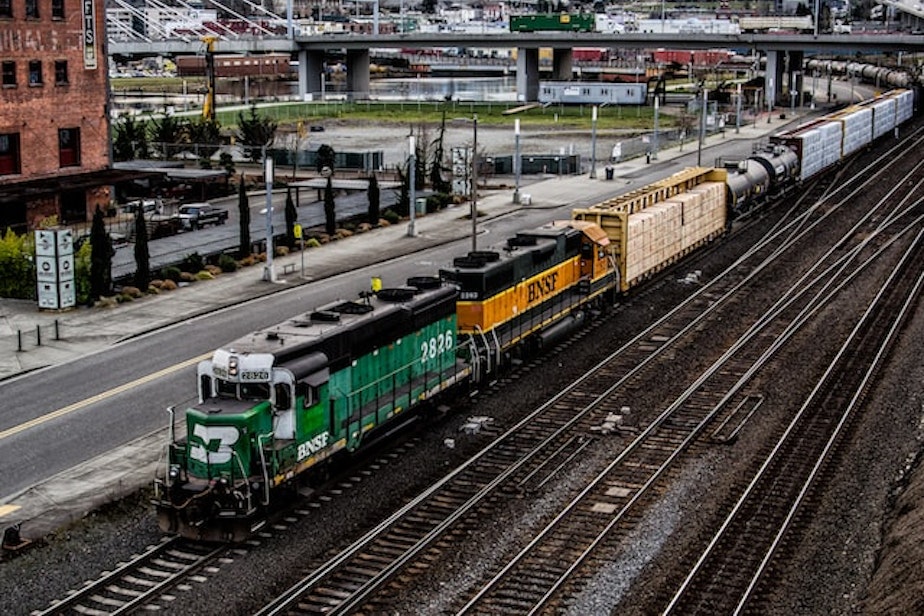What music do you recommend to Seattle newcomers?: Today So Far

- What Seattle music would you recommend to newcomers? In this case, Greg Spotts, the new director of the Seattle Department of Transportation.
- 911 calls in parts of King County are being upgraded with mental health professionals.
This post originally appeared in KUOW's Today So Far newsletter for September 15, 2022.
What Seattle music would you recommend to newcomers? In this case, Greg Spotts, the new director of the Seattle Department of Transportation.
The City Council has approved Spotts for the role and Mayor Bruce Harrell still has to make it official. Spotts has already been on the job in an interim capacity. He's currently asking Seattleites to reach out and take him on a tour of their neighborhoods — by foot, bike, bus, or other — to get an idea of challenges they face.
One point I noticed while writing this all up for KUOW's Blog is that Spotts worked in the music industry in a former life, before going into a career working for cities. This was back in the '90s when he owned a "boutique talent management" company that helped produce albums for REM, Jewel, and Alanis Morissette, among others. With music roots in the 1990s, and Seattle being such a big part of that decade, Spotts says he filled his office with "Seattle vibes" when he came to town by playing music by Nirvana, Alice in Chains, Screaming Trees, and others. In an SDOT blog post he stated, "I know there is so much more Seattle music to listen to, but that was an awesome start."
Which brings me back to music recommendations. Now, to be accurate, the "Seattle sound" was actually a Northwest sound. Screaming Trees were from Ellensburg. Nirvana emerged from Aberdeen/Olympia. So I'm opening this up to our PNW region when I ask: What music artists (newer or older) would you recommend as a primer for SDOT's new director Greg Spotts (or any newcomer)?
To start off, I'd like to throw out there: Murder City Devils; Beverly Crusher; Sunny Day Real Estate; The Black Tones; and The Hoot Hoots (specifically the "Rainbow Squadron" album). Any music recommendations? Email me at dyer@kuow.org.
Sponsored
Have you heard the term "co-responder"? You're going to hear it a lot more as police in our region begin adding mental health professionals into the mix when they take certain calls.
As KUOW's Amy Radil reports, five cities in North King County (Shoreline, Lake Forest Park, Bothell, Kenmore, and Kirkland) have teamed up to ensure that such mental health resources are available seven days a week. The effort is being ramped up to offer a team that can even respond to some calls without an officer present.
In Seattle, Mayor Bruce Harrell has convened a workgroup to address this same issue — adding more mental health professionals for 911 calls. The Seattle Fire Department has already made moves in this direction, and is currently expanding the effort. Its Health One teams launched in 2019. SFD added a third unit this year. When firefighters and EMTs respond to a call, they may encounter someone who needs specific help beyond their scope. They call the Health One team to follow up.
These efforts are happening as King County faces an ongoing decline in mental health treatment beds. KUOW's Natalie Newcomb reports that the county is slated to purchase a long-term residential mental health treatment center in North Seattle. Here's the thing: This purchase won't add any more beds for mental health treatment for our region. If anything, it will just preserve a few, about 64.
King County Executive Dow Constantine recently noted that the county has lost about a third of such beds over the past four years, during a time when the need for these services has increased. According to one King County Council member, the county had 355 residential treatment beds in 2018; today we have 264. That count is about to go down even further (to 244) after another facility closes down later this year. Read more here.
Sponsored
AS SEEN ON KUOW

Many newly arrived Ukrainian refugee children are starting school in Washington state this fall. Some of these children are not yet fluent in English. Sabrina is 12 years old. She is an artist who loves painting landscapes. She is among more than 200 Ukrainians who fled their home country after the Russian invasion and have settled in Washington. (Natalie Newcomb / KUOW)
DID YOU KNOW?
I wrote about the history of the "Star-Spangled Banner" yesterday; a history I didn't know much about previously. I never expected that my education would expand even further in just one day. A TSF reader, Susan, wrote to enlighten me with a few additional facts about the famous event that led to the writing of "Defence of Fort M'Henry," the poem that has become what we know as the "Star-Spangled Banner."
Sponsored
The author of the poem, Francis Scott Key, wrote it in 1814 (the war of 1812 lasted longer than a year) around the theme that despite bombs and rockets hurled by the British, the U.S. flag at Fort McHenry in Baltimore stood firm and waved for all to see. Key saw the flag from miles away. He was aboard a British ship at the time, attempting to negotiate the release of his friend who was held prisoner there. The reason he, and the British, could see the flag from so far away was because it was so massive in scale.
And the reason it was so massive was because of a woman named Mary Pickersgill. She was a skilled flag-maker and was hired to make two U.S. flags for the fort, one 30 x 42 feet and another 17 x 25 feet. The job was too big for Pickersgill's home where she worked, so these flags were built inside a neighboring brewery. Accounts vary on who Pickersgill called in for help, but most state that she had assistance from her mother, daughter, nieces, and a free Black woman apprentice named Grace Wisher. It's possible another Black person who boarded in Pickersgill's home helped out (some accounts note that an enslaved person was also in the household). The flags were completed in six weeks.
Pickersgill was renowned for her flag-making skills, but she was also known for her work with the Impartial Female Humane Society, which worked to provide housing, education, an employment for widows, disadvantaged women and their children.
ALSO ON OUR MINDS

Sponsored
Biden says a tentative railway labor deal has been reached, averting a strike
A strike that could have halted both freight and passenger trains across the country seems to have been averted. After a marathon negotiating session lasting 20 hours, the White House announced early Thursday that a tentative agreement had been reached between rail companies and the unions representing conductors and engineers.

